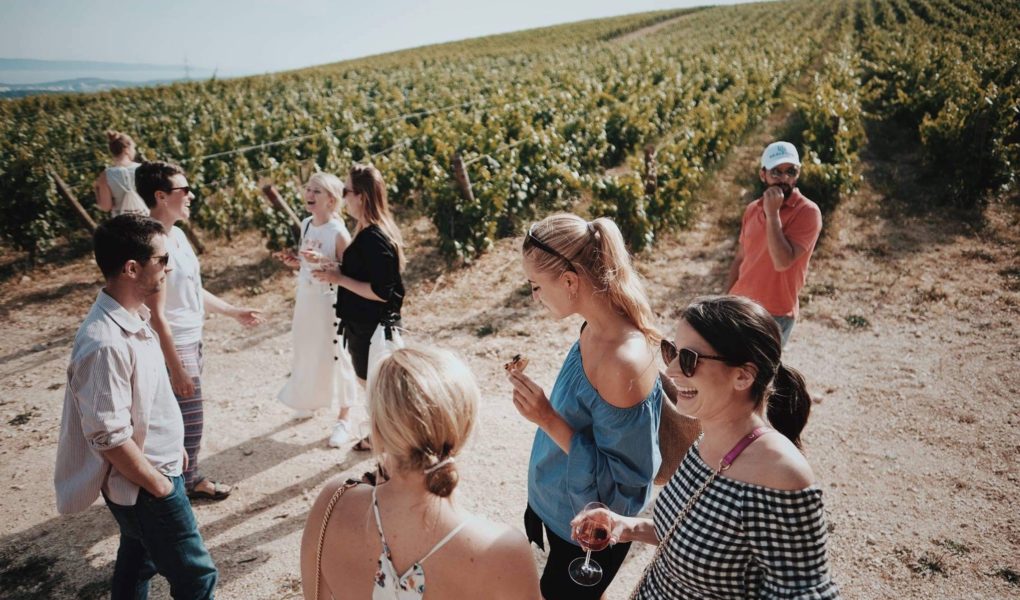When you’re enjoying a leisurely visit to a winery, there’s some truth in the idea that all you need to know is right there in your glass. But when it comes to wine, the story is part of the experience. If you know just a little about what you’re sipping, you’ll better enjoy the story, or be ready to tell your own. Here is a visitor’s guide to Croatian wine that gives you the basics, conveniently color coded by region—so you spend less time reading and more time drinking.
Croatia is a country of unusually diverse natural landscape. Because of this, there are four major wine regions: two coastal and two continental. Each of these corresponds to a different climate and distinct grape varieties that grow best in that climate. And within each are various subregions for winegrowing that may have their own grapes and traditions. The easiest way to become Croatian wine savvy is to focus on the major region you plan to be in, then ask questions about local practices at the wineries you visit. First, though, some helpful background that pertains to all of Croatian wine.
Wine at the crossroads
Croatia has always been located at a crossroads of civilizations. Visitors see, feel, even taste the influences of Croatia’s historic cultures today. Wine was made here from at least the arrival, in the fifth century B.C., of the ancient Greeks on the islands of Vis, Hvar and Korčula. A few centuries later, most of today’s Croatia was part of the Roman empire, and grapes for wine were cultivated widely.
After the introduction of christianity, monks helped to further winegrowing and making, just as in other regions of Europe. In medieval Croatia, these monks helped ensure the survival of winemaking during Ottoman rule. Next came Hungarian and Austrian rule (mostly inland) and that of the Venetian Republic (on the coast and islands). Visitors can immediately see the lasting imprint of these empires on architectural styles and on restaurant menus as they travel between continental and coastal Croatia.
Croatia’s 45 years of communism undoubtedly still impact winemaking here. Still standing all over the country are the state-run cooperative wineries where farmers were required to sell the bulk of their grapes from 1945 to 1990. Any wine made at home was for family use only and could not be sold commercially.
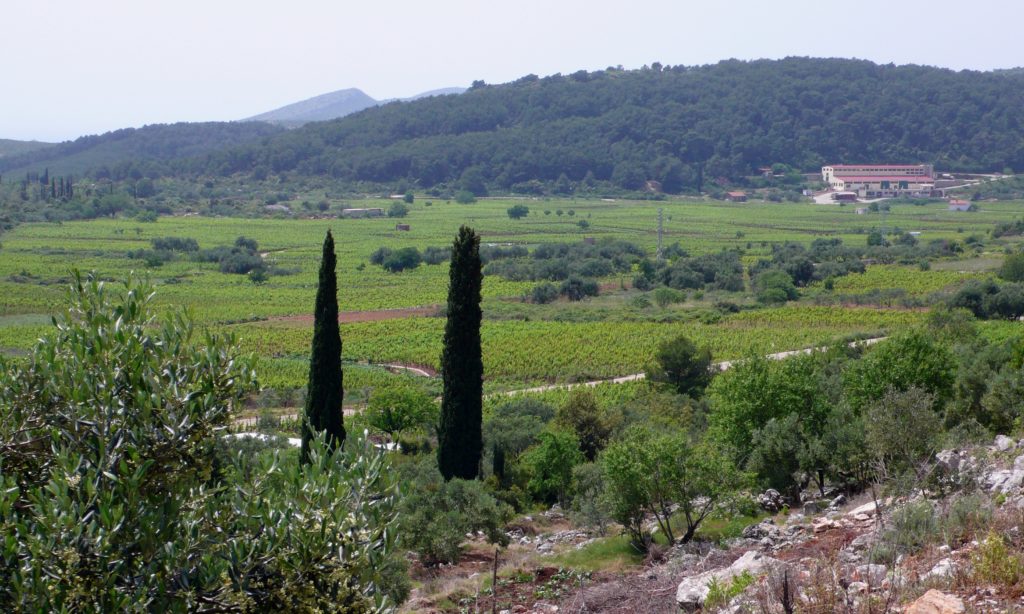
The government valued quantity over quality in the grapes brought to the co-ops and the wine produced there. Because of this, there was little incentive during these years for growers to improve their methods or for private wine makers to follow quality developments in the rest of the world. Even if wine makers could get information, there was no way to get modern equipment.
The result was that modern Croatian winemaking began after the breakup of Yugoslavia in 1991 (although it was further delayed in many areas because of the War of Independence). Only then could quality-minded wine makers begin to obtain temperature-controlled vats, cultivated yeasts and other advanced technology and finally begin producing and selling wine of their own.
An eye on quality
Croatian wine makers have quickly made up for lost time. Most of the country’s small wineries are family owned, and often one or more children of these families has attended school for enology and worked at wineries abroad, bringing home new ideas and practices.
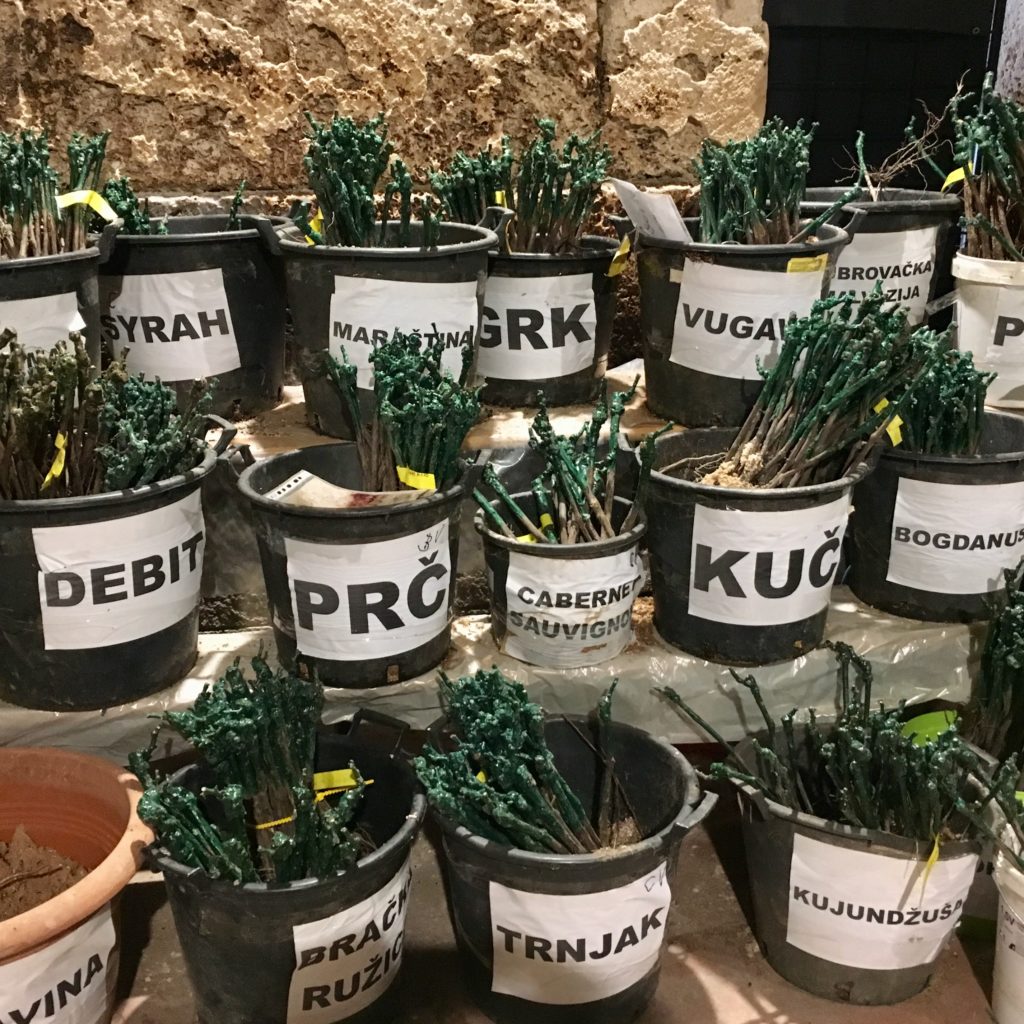
One of the fascinating aspects of Croatian wine is the large number of native grapes that have survived here. Wine makers take pride in their wines from these local varieties, which shine a spotlight on their own region, even if many also produce wines from international varieties such as Cabernet Sauvignon or Merlot.
In addition to private producers, many of the cooperative wineries once run by the state still operate, buying grapes from the growers and mixed farmers in their area. Some of these co-ops have become known for making excellent quality wine.
Clearly, Croatia makes some world-class wine. But the transition from farming for quantity to adopting best practices is a process. There are still plenty of people making wine the same way they or their families did 50 years ago, and many Croatians swear by their own family’s wine. This may be well made and very enjoyable, or not.
It may help to know that quality standards exist and are usually printed on the wine label. A wine maker who wants to sell his or her wine commercially must first follow the rules of winemaking set up for their region concerning grape variety, vineyard practices and yield, winemaking and aging, and many other factors. Once made, each year the wine must be submitted for evaluation by a central authority which grants a quality ranking. Here are the terms you may see on the wine label, and what they mean.
Zaštićena oznaka izvornosti (ZOI) or Protected Designation of Origin (PDO) There are 16 ZOI regions (PDOs in English) in Croatia. If a wine maker follows the guidelines for wine made in that region and the wine is judged to be typical of the region, it can use this terminology plus the name of the region. This can be used in combination with one of the quality levels below, or on its own.
Stolno Vino Table wine. This is the basic quality level—some is well made, some isn’t.
Kvalitetno Vino Quality wine. The middle quality level, which comes with stricter guidelines in the vineyard and the winery.
Vrhunsko Vino Top-quality wine. The top level, with strictest guidelines.
As with most things, it comes down to which wines you like best. And to some extent, you get what you pay for. There are a few great wines for 40 kuna (5 euro/6 US dollars) a bottle, and hundreds more between 40 and 100 kuna (13 euro/15 US dollars). You can go much cheaper, but you’ll go home with a very different impression of Croatian wine!
The great wine hunt
Croatians who drink wine usually buy it in the grocery store, or they bring a container to their local konoba (tavern) or co-op to be filled with wine of everyday quality. Larger supermarkets offer a wide selection of generally affordable wine, with the greater part of it coming from the region where the supermarket is located.
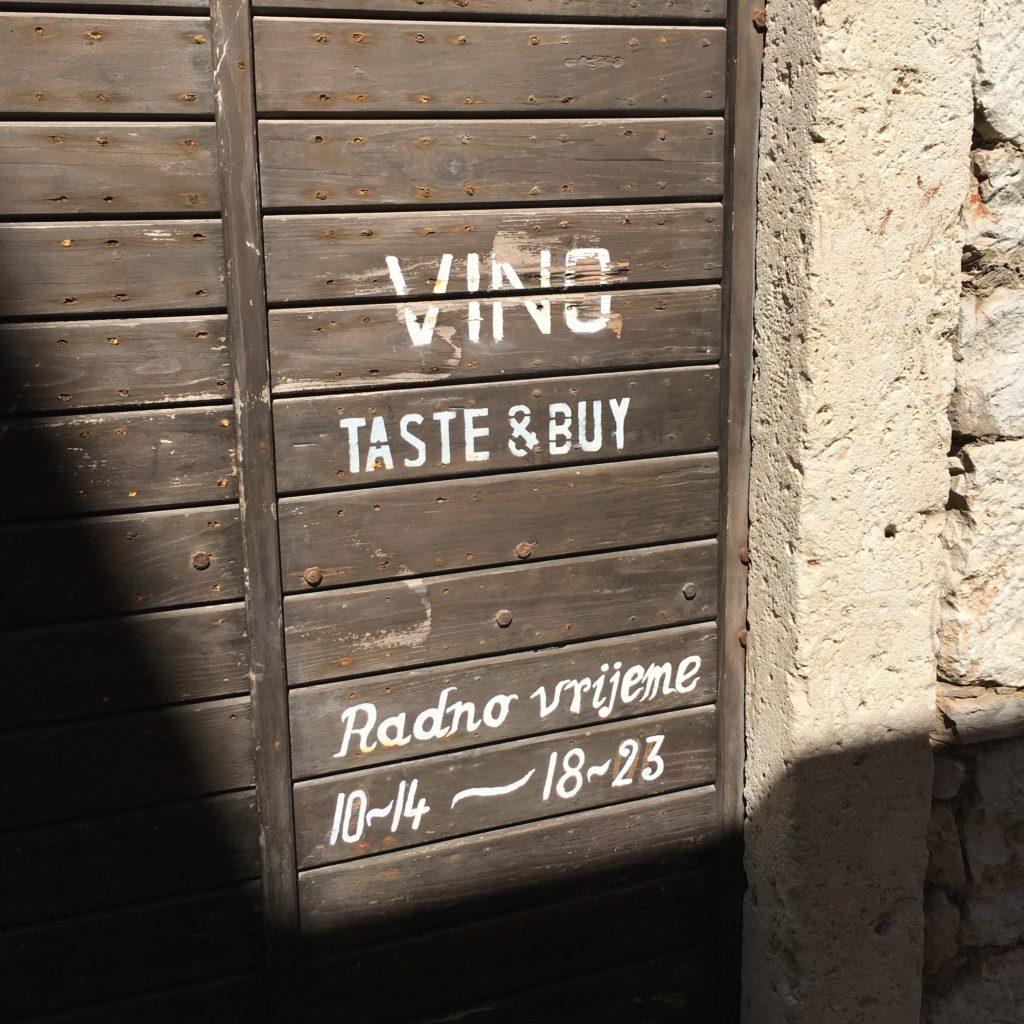
Visitors from other parts of the world may be accustomed to finding large wine-and-spirits shops with a wide selection of international wines. The situation is a bit different in Croatia. Wine shops exist in the larger cities, but you may find the selection limited to Croatian wine plus a few imports from Italy and Slovenia, and a selection of high-end French wine. Browsing a wine shop is wise if you want something special, which you are less likely to find in the grocery store. In smaller towns gift shops selling local products often carry wine. And if you try something irresistible in a restaurant, you may be able to buy an unopened bottle from them—just ask.
It may be the most fun, of course, to visit wineries and buy wine directly from the source. It is also generally the cheapest option. For tips on visiting wineries in Croatia, read this.
Four regions, a vast variety of wines
Croatia is a country of unusually diverse natural landscape. Because of this, there are four major wine regions: two coastal and two continental. Each of these corresponds to a different climate and distinct grape varieties that grow best in that climate. And within each are various subregions for wine growing that will have their own grapes and traditions.
One of the best ways to get to know a wine region is to try wines from indigenous grapes, of which Croatia has an unusual number, especially in Dalmatia. Wine makers know the value of these and many make a point of holding onto their native vines.
But the most promising development to look out for is experimentation—wine makers who follow their ideas and see what comes of them, whether it is orange wine, sparkling wine, natural wine or some variation in blending or aging. Keep an eye out for the unusual!
The four main wine regions are color-coded on the map below. The text for each region is keyed to the color of the map, for easy scrolling.
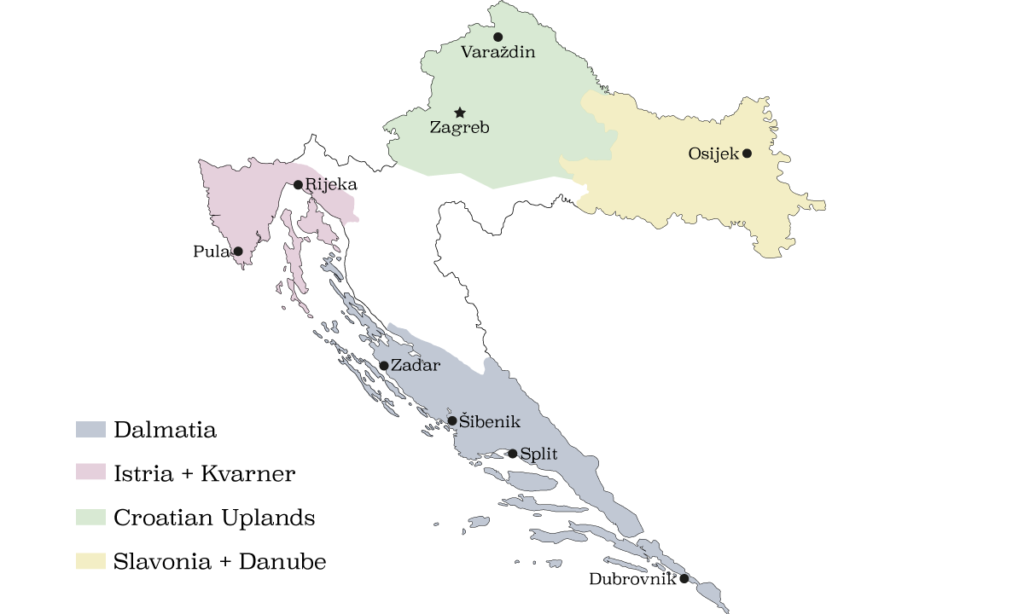
Dalmatia
The Dalmatian wine story that has captivated the world was the discovery in 2001 that the California black grape Zinfandel has Croatian origins. It is genetically the same as Crljenak Kaštelanski, also called Tribidrag, an old Dalmatian grape that had all but disappeared from the vineyards of the region. The connection to the blockbuster American grape inspired local winegrowers to plant Crljenak once again. A number of wineries around Split and on the nearby islands now make wine from this grape. But don’t expect a Cali Zin experience—even an identical variety develops different fruit qualities in different places. Croatia’s “Zinfandel” is a little wilder and earthier than the California version.
Dalmatia stretches from Pag island in the north, along the coast past Dubrovnik to the southern tip of Croatia, and includes the islands along this length. The sunny Mediterranean climate suits heat-loving grapes, especially on the south-facing slopes of the coastal mountains and islands.
Limestone is key in this region. It forms a large part of the Dinaric Alps, which create a border between coastal and continental Croatia. (In fact, the islands are the submerged western peaks of this range.) Eroding limestone also creates a scrubby, rocky landscape called karst. Many of Dalmatia’s vineyards grow on karst or a combination of karst stones (limestone) and other soils. Winegrowers say that, on the steep southern slopes of Hvar and the Pelješac peninsula, the sun ripens the grapes from three directions: from the sun itself, its reflection off the sea, and its reflection off the white karst stones beneath the vines.
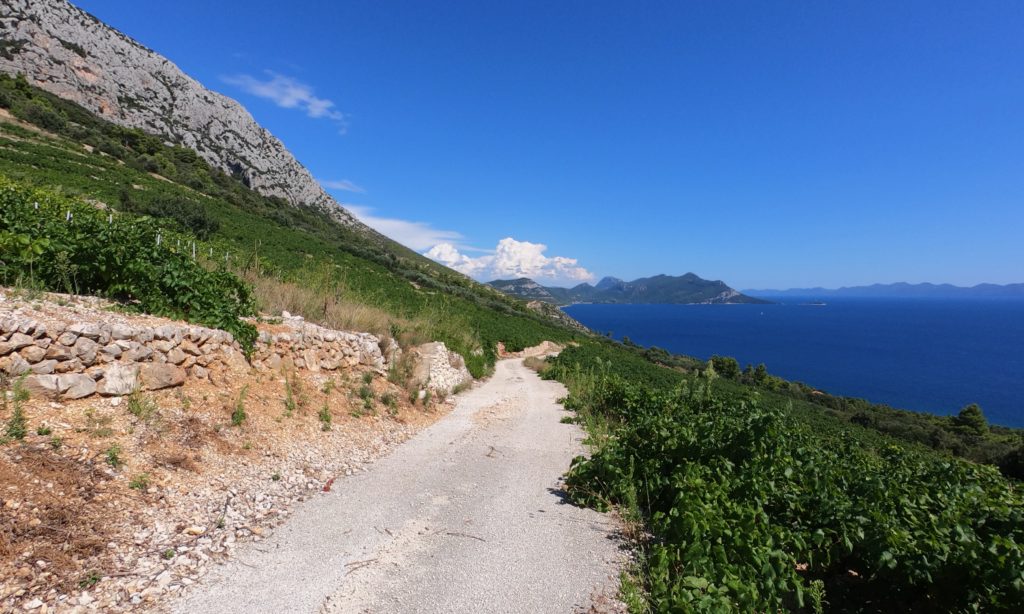
There are dozens of grapes that grow only in Dalmatia and nowhere else in the world. In white grapes, the best known is Pošip, whose home is on the island of Korčula, but which grows on much of coastal Dalmatia to the south of Split. Pošip is generally a rich, fruity wine. Other specialties are Debit (in the area around Šibenik), Maraština and Bogdanuša (Hvar and north), Vugava (Vis), Grk (Korčula) and Kujundžuša (Imotski region).
Red wines are made all over Dalmatia from Plavac Mali, the region’s most important black grape. Crljenak (Croatia’s Zinfandel) is one of the genetic parents of Plavac Mali, and wines from Plavac have a ripe, juicy, black-cherry richness (and are often high alcohol) that make it easy to see the relationship. The most highly regarded locations for Plavac Mali are the growing areas of Dingač and Postup on the Pelješac peninsula (look for Dingač or Postup on the wine label), and the vineyards on the south side of Hvar island. Other black grapes to look for in Dalmatia are Babić (in the area around Šibenik), Drnekuša (Hvar), and of course Crljenak Kaštelanski/Tribidrag (widely around Split).
Istria + Kvarner
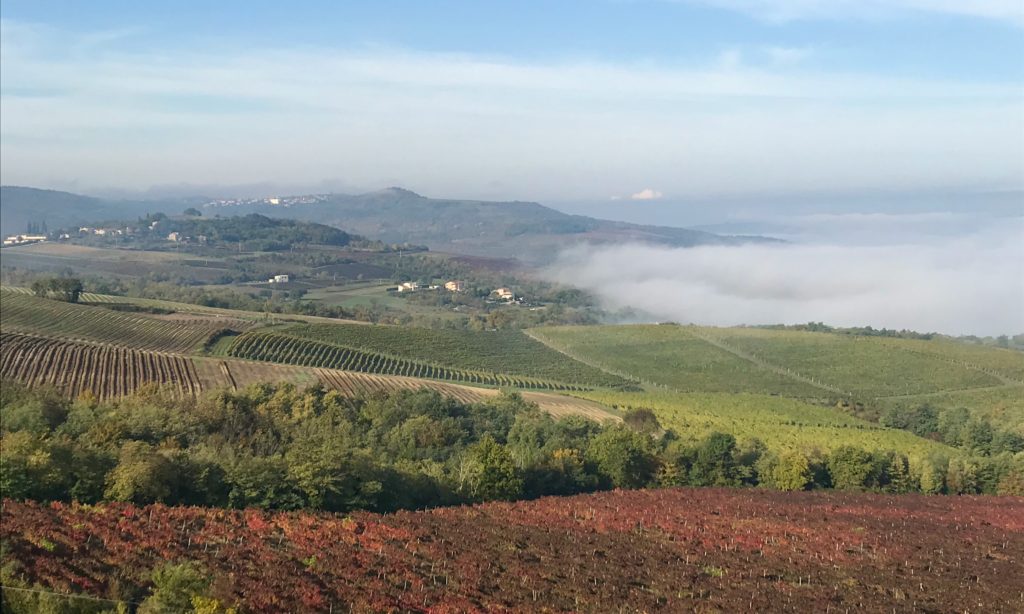
The region of Istria, the peninsula on the far north of Croatia’s coastline, may seem to be an island unto itself. Istria and much of Kvarner, the region around Rijeka that includes the islands of Krk, Cres and Lošinj, are cut off from the rest of Croatia by the Dinaric Alps. The fact that three countries—Italy, Slovenia and Croatia—have a share of the Istrian peninsula gives an idea of the diverse influences at work in the region.
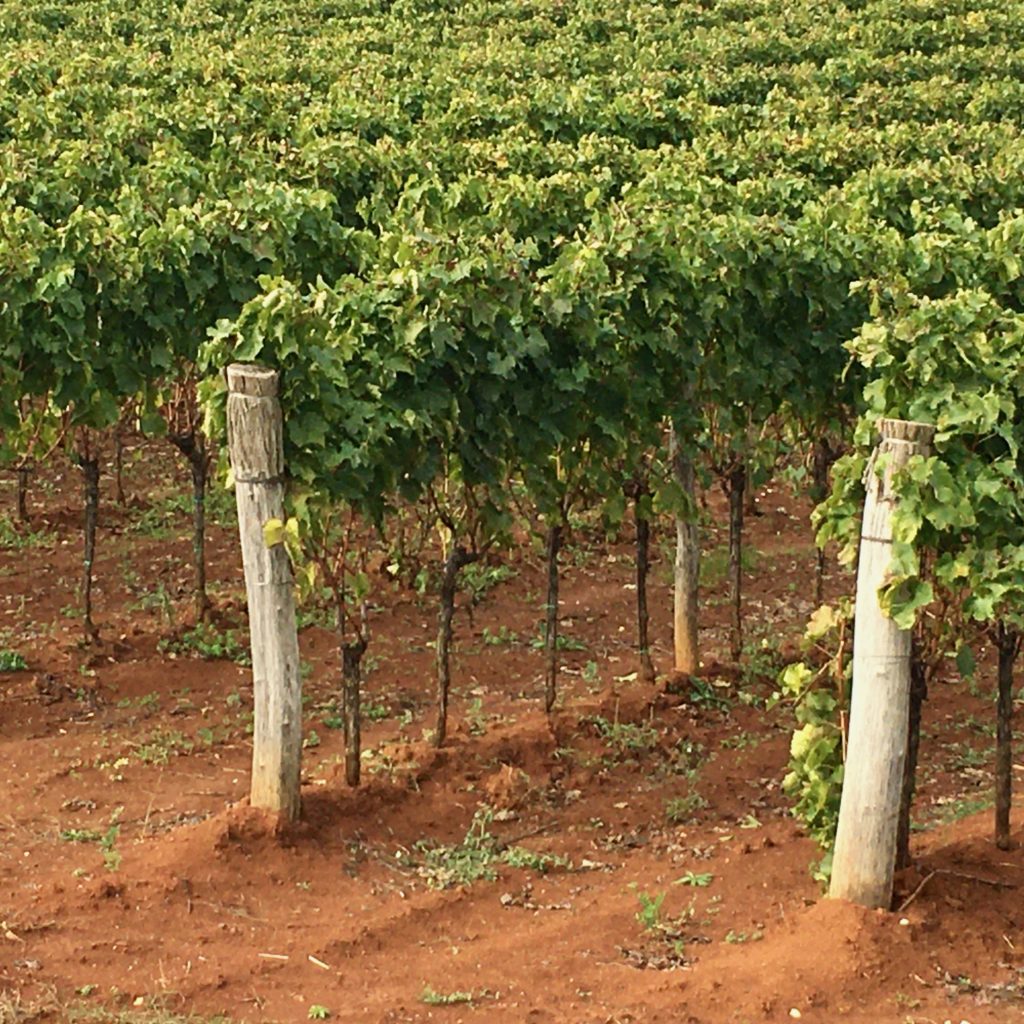
Here, much of the vineyard land is inland, where rolling hills catch cooling morning fogs that burn off in the intense sun of the day. The coastal area has a typical Mediterranean climate, but inland this veers toward continental as cold air filters down from the Alps to the north.
Istria has four soil types—black, gray, red and white. The terra rossa, bright red due to its iron content, is the easiest to spot. Each soil has a slightly different effect on the wines that come from them.
Malvazija Istarska (Istrian Malvasia) is the star white variety here and is considered to be indigenous. Basic Malvasia wine is light and floral. If it is given longer maceration or aged in oak or acacia barrels, the wine will be golden, concentrated and multilayered. Given the right winemaking, Malvasia is one of the most age-worthy Croatian wines. Muškat is also grown here, made into dry or sweet wines, notably Muškat Momjanski in the area of Momjan.
Istria’s best known black grape is Teran, also called Refošk. It, too, can range from fruity and peppery to seriously intense and ageable, depending on the intentions of the wine maker. International grape varieties, especially Merlot, are also planted here.
In Kvarner, the mountainous region between Istria and northern Dalmatia, Krk island is the winegrowing focal point. The northern end and edges of the island are scoured clean of vegetation by the bura, the fierce north wind that whips down the coastal corridor. But in the center and the protected valleys of the island, grapevines thrive. The local white grape here is Žlahtina, light and crisp; Sansigot is becoming the island red wine, made from a grape variety rescued from near extinction. International varieties such as Cabernet Sauvignon and Syrah are also grown.
Croatian Uplands
The Croatian Uplands form a broad swathe around Zagreb. This is Croatia’s coldest wine region, and the hills that give the Uplands their name allow rows of vines to be oriented to the sun, to catch as much light and heat as possible.
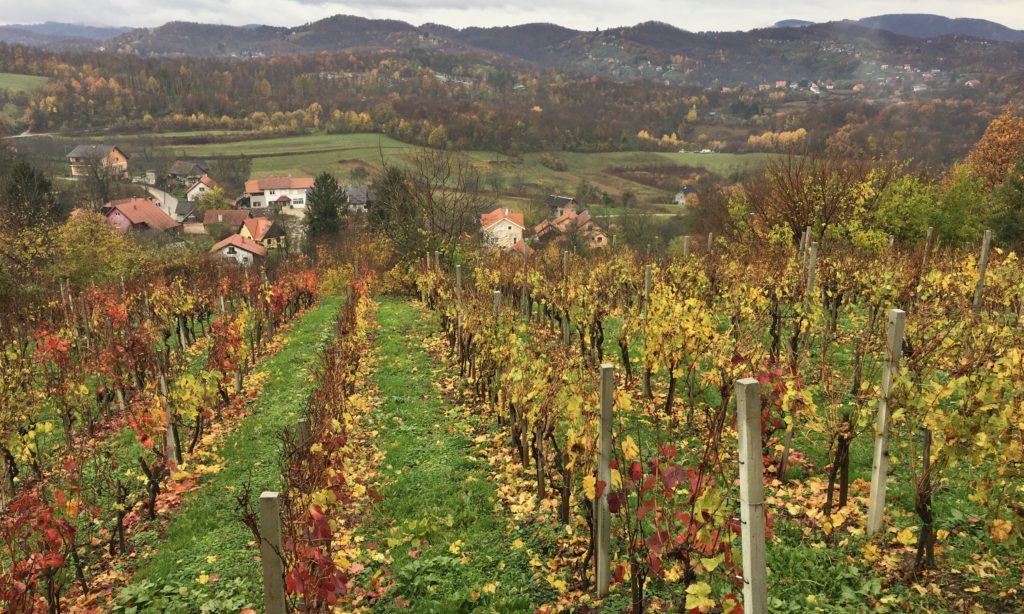
Cold climate winegrowing focuses on white grape varieties—the cold preserves the delicate aromas in wines from Sauvignon Blanc, Rhine Riesling (the most common grape in this region) and Furmint, known here as Pušipel or Moslavac.
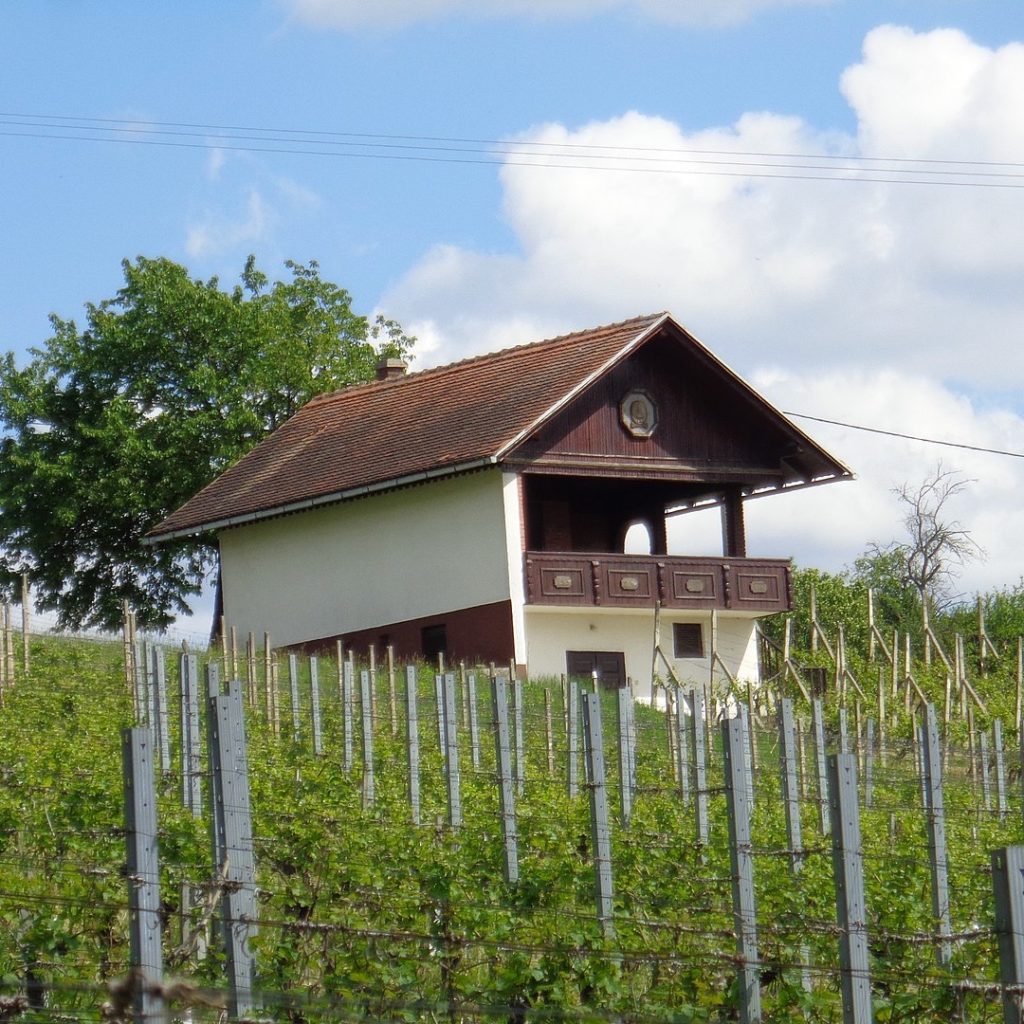
While most of the varieties grown in the Uplands are not indigenous to the region, there are two white grapes to look out for that are thought to be native. Škrlet is common in the Moslavina subregion southeast of Zagreb. It was all but extinct but was revived in the 1990s and makes a delicate wine best consumed fresh (within a year or two of the vintage). Kraljevina, which means kingdom, is a zesty white specialty of Prigorje-Bilogora, east of Zagreb.
Black grapes are also grown here, particularly those that tolerate the cold: Pinot Noir, Frankovka (Blaufränkisch), Zweigelt and Portugizac (Blauer Portugieser) which is used to make Croatia’s version of Beaujolais Nouveau.
The cold climate of the Uplands is uniquely suited to sparkling wine production, and a number of wine makers, particularly in Plešivica, west of Zagreb, have heeded the call. Many have chosen to grow Chardonnay and Pinot Noir (two of the varieties used for Champagne, in France) and make the wine using the traditional method of the Champagne region.
Slavonia + Danube
In Croatia’s far east, tucked between Hungary, Serbia, and Bosnia and Herzegovina, lies the country’s most productive wine region. Much of this area was covered by the ancient Pannonian sea. Today, sediments that once formed the seafloor enrich the low hills and valleys where large swaths of wheat and vines grow. In the foothills of western Slavonia lies the Vallis Aurea (Golden Valley), the name given by the ancient Romans to the valley where Požega and Kutjevo are located. All of this rich farmland is tied up in three blue ribbons: the Drava, Sava and Danube rivers that form its borders.
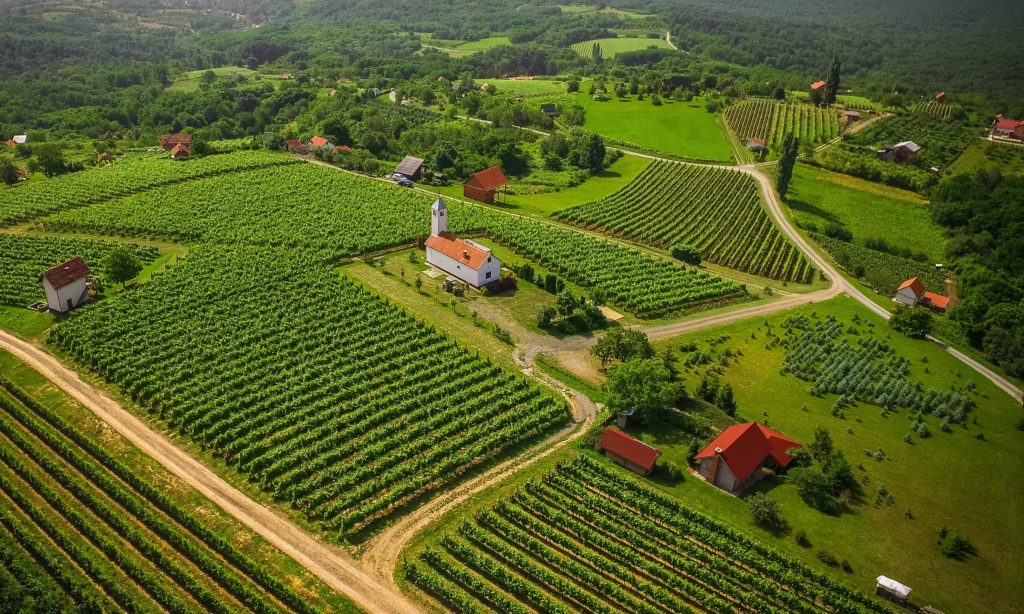
Here the mild but cool continental climate encourages white varieties, as in the colder Uplands. Graševina dominates this region—and is by far the most planted variety in all of Croatia. In other countries it is known as Welschriesling, although it has no relation to actual (German or Rhine) Riesling. In Croatia this versatile variety really comes into its own in wines ranging from sparkling to dry to oak aged to semisweet and sweet. Simple, easy Graševina has a zesty green-apple freshness; fuller-bodied versions often have tropical fruit notes, possibly given further depth by aging in oak.
Oak itself is a notable product of Slavonia—most wine makers in the region use Slavonian oak barrels for their aged wines, as do wine makers in Italy and elsewhere who favor the specific qualities of oak from Slavonia.
Closer to the Danube in the east, especially around Ilok, Traminac is the star grape. This variety is the same as Gewürztraminer and has a typical heady floral perfume, whether dry or sweet. Other white grapes grown here tend to be international varieties such as Rhine Riesling, Pinot Gris and Chardonnay.
In red wine, international varieties dominate, such as Pinot Noir, Frankovka (Blaufränkisch), Merlot and Cabernet Franc. Many of these are elegant wines that pair beautifully with food.
[Cover photo: courtesy Kairos Vina]

